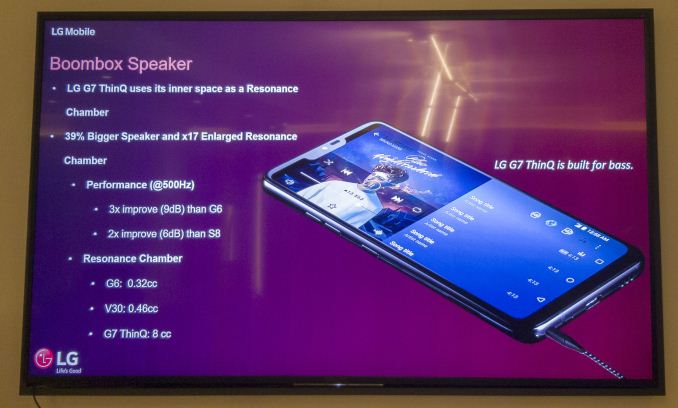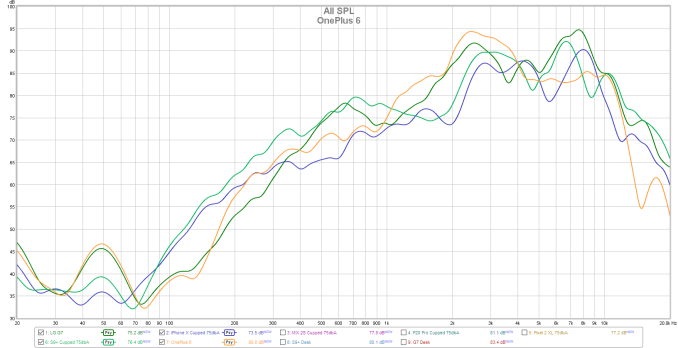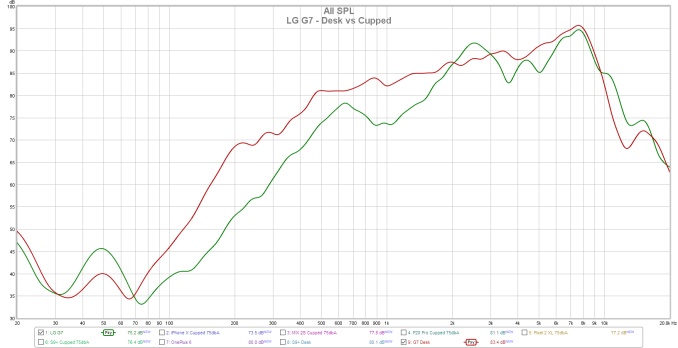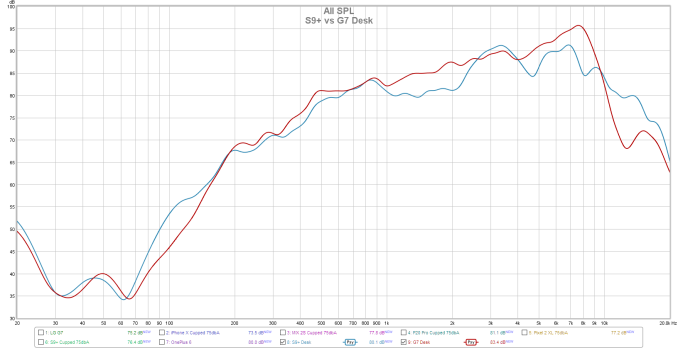The LG G7 Review: A Rushed Attempt?
by Andrei Frumusanu on August 9, 2018 11:00 AM EST- Posted in
- Smartphones
- LG
- Mobile
- LG G7 ThinQ
- LG G7
Video Recording
Video recording on the G7 is actually a very interesting topic because you have the two cameras to choose from. In terms of recording modes the phone is limited to 4K30 as its highest quality mode, while 60fps recording is enabled only for 1080p. There are also 18.9:9 aspect ratio resolutions at 2268x1080 and 1512x720 at 30fps which give you a wider field of view. EIS is only applied at 1080p30 and below.
In terms of encoding settings, the G7 only uses AVC/H.264 and doesn’t take advantage of the SoC’s more powerful HEVC encode mode. The encoding bitrates are standard for the respective resolutions and capture rates.
Main Camera:
Wide Angle:
| Recording Mode | AVC / H.264 |
| 3840p 30fps | High@L5.1 - 47.9 Mbps |
| 1080p 60fps | High@L4.2 - 24 Mbps |
| 1080p 30fps | High@L4 - 17 Mbps |
The 60fps capture modes suffer a lot from either a too low encoding bit-rate or the ISP isn’t doing as much processing, as it’s immediately visible that there’s far less dynamic range and detail compared to the 30fps modes. And it happens on both cameras.
1080p and 4K look good on both camera modules, although the lack of OIS is very visible in the wide-angle shooter. EIS functions extremely well and manages to retain a lot of detail – it’s to be noted that the occasional blurring jitter in the videos here is more of an effect of the YouTube transcoding, as the effect isn’t nearly as bad in the original video files.
What I really loved though about the G7 is the wide-angle recording in combination with EIS. I usually don’t enjoy EIS video capture because it really narrows your field-of-view too much in most cases, however on the G7 the wide-angle lens cancels out any disadvantages of the EIS, and you end up with a FOV that’s still wider than most other smartphones, with the benefit of great stabilisation.
The sound recording quality of the G7 was good, although I found that wind noise was a lot more pronounced than in other smartphones.
Overall the only larger criticism here is the loss of picture quality in the 60fps modes as well as overall the lack of being able to capture in HEVC as that would have noticeably increased picture quality without increasing file size.
Speaker Evaluation
LG made some big claims for the speaker of the G7 as it promised some really notable gains with its new design.
During our pre-brief we were presented with a few basic specs: the speaker is 39% bigger than on the G6, and also the resonance chamber is said to be the biggest of any smartphone. Instead of using the speaker housing as resonance chamber, the G7 uses the whole internal volume of the phone. This was also very much achieved thanks to the sealed nature of the phone through its IP68 rating. What this promises is vastly increased bass levels than any other phone.
First up though, let’s measure the speaker loudness. We’re using a flat response calibrated microphone and we’re measuring pink noise at a 40cm distance from the phone. The phone is held both one-handed in portrait mode, as well as two-handed with cupped palms in landscape; both of these should represent common use-cases for most people.

The results are extremely good for the G7, as it manages the loudest results among recent flagships. What is more remarkable still for the G7 is actually the directionality of the sound. Even though it only has one speaker and it’s bottom/side firing, this doesn’t seem to really hinder it much in terms of having excellent frontal directionality. I was really surprised at just how well this works and it easily outperforms even some true front-facing speakers of other phones. The sound directionality and evenness in portrait mode is particularly excellent.
Holding the phone in landscape is tougher though as it’s very much biased towards the side of the speaker and here the phone doesn’t fare as well as other stereo implementations.
Moving on to the frequency response of the speaker, we’re measuring a sweep from 20 to 20KHz, in the same conditions as our previous test, while holding the phone in landscape mode with two hands. All the phones are calibrated to the same loudness, aiming for 75dbA.
Although LG promised a lot of bass through the new speaker, it it actually ends up as one of the worst performers. The phone is significantly lacking in terms of depth, sounding very hollow. This is represented by the low SPL below 400Hz.
Investigating it more, one of the things LG did during the presentations of the phone is to showcase how the sound profile significantly changes when you lay it down on a surface. Indeed, while you hold the phone you can really feel the reverberations on the back glass of the phone. The problem here is that this is just wasted energy that doesn’t translate into any meaningful sound. Putting the phone on a standing surface allows the phone to transfer the vibrations and use the surface to amplify the sound.
I tested this out on my work desk, with once the phone held in my hand on the desk, and then again with the phone’s back flat against the desk.
Looking at the frequency response, we now see all that low frequency energy transfer to the desk and really amplify the low to mid frequencies of the phone, resulting in a much flatter frequency response.
To better represent the difference, here are two audio recordings of the two scenarios. Unfortunately I don’t have a proper omnidirectional recording microphone to capture this too well, so the recording was made with the measurement microphone – the issue with this one is that it lacks sufficient dynamic range and that’s why it sounds more muted. Here’s a recording of flat response speakers that should serve as an apples-to-apples baseline for comparison.
You can switch playback between the two recordings by pressing anywhere on the waveforms, and the recordings are synchronized in terms of their timestamps. This really represents the large audio profile difference between holding the G7 and putting it on a surface.
While this is all good in terms of looking at the frequency response, there’s a big catch when comparing the G7 to competitors. Putting the Galaxy S9+ onto the desk right next to the G7 and repeating the measurement, we actually see the Samsung phone perform even better in terms of bass as well as showcasing a significant advantage in the high frequencies.
When listening to the recording of the S9+ next to the G7, it puts the G7 into context, suddenly makes one question what the actual benefits of LG’s speaker design is. The coup de grâce for LG’s speaker is the fact that other phones don’t need to be put onto on a surface to be able so sound good; the S9+’s sound profile barely changes between holding it or putting it down. The G7 in the other hand just sounds bad when you’re holding it.
The most interesting fact is that when holding the phone, you can squeeze in the back side quite hard – what this does is reduce the internal reverberation and vibrations, and vastly increases the amplitude of lower frequencies actually coming out of the phone, noticeably improving the bass and depth of the audio.
Here’s the thing; while LG’s idea has some kind of merit and does work in some cases, a smartphone is still a handheld device, which by definition you hold it in your hand. Taking all of this into account, I don’t really see LG’s new speaker design paying off and I would even go as far to say that I somewhat prefer the G6’s sound, although that one isn’t great either.














69 Comments
View All Comments
johntmosher - Thursday, August 9, 2018 - link
My LG G4 died from Boot Loop a little over a month after the warranty expired. Verizon and LG did not offer anything to make up for the fact that it was sold to me at a time when they already knew about the Boot Loop failure rates. LG and Verizon are both on my shit list and will stay that way for quite some time.takeshi7 - Thursday, August 9, 2018 - link
I don't care about waterproofing on my phone. LG needs to bring back removable batteries. That's the whole reason I bought their phones. If I want waterproofing I'll go out and buy a waterproof case.UtilityMax - Friday, August 10, 2018 - link
Just buy a power bank. Removable battery as a run time extender is as inconvenient as it gets. Also, some of those low-end smartphones with A53 CPUs as their main cores can get an amazing run time. I can forget to charge my honor 6X and it can still last through the day with just 40% in the morning.jabber - Saturday, August 11, 2018 - link
Yeah I have a LG G4 which has been a great phone but this September I am coming up for three years with it and was going to replace it (probably a G6). However, I remembered I could change the battery and really the G4 still does everything I need so I just got a new battery. Sorted for another year at least...Dragonstongue - Thursday, August 9, 2018 - link
so even higher specs with a low Mah battery, for shame..."modern" smartphones IMO especially the ones that have high to very high end (for phone) specs should not hamper them with "normal" size batteries that tend to be in the range of 2200-3200 they should be targeting a minimum of 3200-4200 range, especially when they have the space to cram a larger battery in there (which many of them do)I just don't get t when "knock off" brands manage to often use a better display AND larger battery, shame of the bigger companies expecting as much $ as they can think to get away charging and using a dinky little battery....example even lower spec G4 Play had a 2800Mah battery REMOVABLE, this is much higher spec but barely any increase in battery capacity, I do not give a crud what OS version it is using, the capacity of the battery matters very much >:(
Xex360 - Thursday, August 9, 2018 - link
The notch again no innovation especially from LG, I had the V20 and the second screen can be very useful and didn't ruin the whole experience, the G6 were nearly perfect beside the decision to use a year old SOC plus no wireless charging.hirschma - Thursday, August 9, 2018 - link
The LG V35 is what should be the flagship. Better specs, better display, more memory, plus the audio, wide angle camera and 845 from the G7. I've had mine for a week, and it's definitely the best phone I've ever had.Hubb1e - Thursday, August 9, 2018 - link
I got this phone after some bad experiences with Samsung and this is the most accurate review of it I've seen to date. The biggest downside for the G7 is the unreliable camera. Some shots are okay, some are downright bad. And most reviewers don't shoot pictures of moving subjects, but the G7 consistently misses focus on moving subjects. All the issues with the camera in this review I've seen in my use. Most of it I think is related to it's inability to auto focus on the correct subject. When using manual focus, the camera actually takes good pictures.The rest of the phone is actually really great. I don't notice the color calibration in regular use, and the speaker is great even if other flagships also offer great speakers. The size of the phone is the best out there. It is comfortable and has a large screen without feeling too wide to hold and use in one hand. While I do mostly use BT headphones, I have a range of wired headphones and when I use them they sound amazing on the G7 in comparison to other phone's weak headphone output.
And the last great feature, but one that was not touched on in this review, is the outstanding idle battery life of the G7. Even with the always on display enabled, the G7 barely loses any charge when idle. If I don't use my phone very much, I can end the day with 80% of my battery life left. Most days I have 40-50% of battery left over even taking pictures, making calls, watching videos, and browsing the web. In comparison to Samsung phones I've had that can lose 5% an hour at idle, the idle power use of the G7 makes it outlast every other phone I've ever used.
SkyBill40 - Thursday, August 9, 2018 - link
I have a V30 after having upgraded from a V10 a while back. Personally speaking, I'd rate the V series above the G series but that's just me. I can say that I've been quite satisfied with my V30 and given how close to each other these phones happen to be, it wouldn't be worth it to "upgrade."LG has come a long way with their phones (that boot loop issue was a killer) and are genuinely competitive with every other high end device out there.
Lavkesh - Thursday, August 9, 2018 - link
Its amazing how average these so called Android flagships are when compared to the iPhone where every details is thought out. The worst thing is that they arent cheap either.